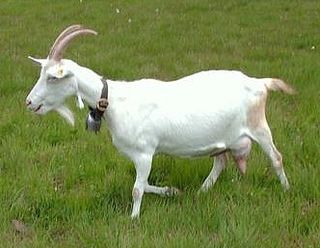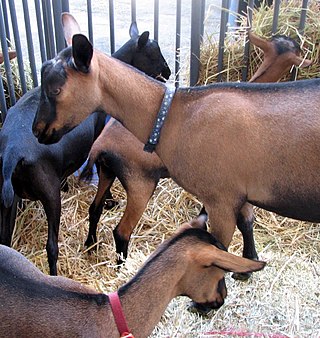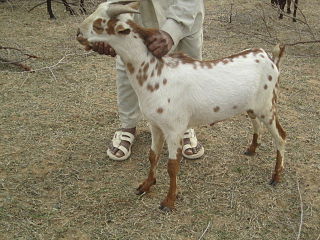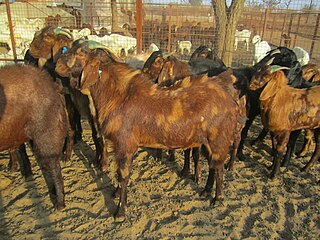
The American Pygmy is an American breed of achondroplastic (dwarf) goat. It is small, compact and stockily built. Like the Nigerian Dwarf, it derives from the West African Dwarf group of breeds of West Africa. Between 1930 and 1960, animals of this type were imported to the United States for use either as zoo animals or for research; some were later kept and bred as companion animals and established as a breed in 1975.

The Nigerian Dwarf is a modern American breed of dwarf goat. Like the American Pygmy Goat, it derives from the West African Dwarf group of breeds of West Africa.

The Saanen is a Swiss breed of domestic goat. It takes its name from the Saanental in the Bernese Oberland, in the southern part of the Canton of Bern, in western Switzerland. It is a highly productive dairy goat and is distributed in more than eighty countries worldwide.

The Toggenburger or Toggenburg is a Swiss breed of dairy goat. Its name derives from that of the Toggenburg region of the Canton of St. Gallen, where it is thought to have originated. It is among the most productive breeds of dairy goat and is distributed world-wide, in about fifty countries in all five inhabited continents.

The Oberhasli is a modern American breed of dairy goat. It derives from the subtype of Chamois Colored Goat from the Oberhasli district of the Bernese Oberland in central Switzerland. All purebred members of the breed descend from five Chamois Colored Goats imported to the United States in 1936. A breeder's association was formed in 1977, and a herdbook established in the following year. Until then, goats of this type had been known as Swiss Alpine, and interbred with Alpine goats of other types.

The Devon is a traditional British breed of beef cattle. It originated in, and is named for, the county of Devon in the West Country of England. It is a deep rich red in colour, and so may be known as the Devon Ruby, Ruby red or Red Ruby; it may also be called the North Devon to distinguish it from the South Devon.

The Anglo-Nubian is a British breed of domestic goat. It originated in the nineteenth century from cross-breeding between native British goats and a mixed population of large lop-eared goats imported from India, the Middle East and North Africa. It is characterised by large, pendulous ears and a convex profile. It has been exported to many parts of the world, and is found in more than sixty countries. In many of them it is known simply as the Nubian.

The Golden Guernsey is a rare breed of dairy goat from Guernsey in the Channel Islands, where it has been known for more than two hundred years. In 2024 it received a Royal title from King Charles III and is officially the Royal Golden Guernsey Goat.

The Appenzell, French: Chèvre d’Appenzell, German: Appenzellerziege, is a rare and endangered indigenous breed of white domestic goat from Switzerland. It originates in the "half-cantons" of the historic Appenzell region, Appenzell Ausserrhoden and Appenzell Innerrhoden, and has spread into the neighbouring Canton of St. Gallen.

The Barbari or Bari is a breed of small domestic goat found in a wide area in India and Pakistan. It is distributed in the states of Haryana, Punjab and Uttar Pradesh in India, and in Punjab and Sindh provinces of Pakistan.

The Danish Landrace is a Danish breed of dairy goat.

The Dutch Landrace is a traditional Dutch breed of domestic goat. It has been known in the Netherlands since the seventeenth century, and was formerly numerous there. It came close to extinction in the 1950s, but was saved by cross-breeding with unrelated goats, and by 2020 numbered over 2000 head.

The Irish Goat is a traditional Irish breed of domestic goat. It is a dual-purpose breed, used both for meat and for milk. It is an endangered breed and may survive only in feral populations. It is distinct from the feral Bilberry Goat of Waterford.
The Laoshan goat breed from the Shandong Province of China is used for the production of milk. It is derived from the selective breeding of local goats crossed with Saanen goats first introduced to the area in 1904.

The Russian White Dairy or Russian White is a Russian breed of dairy goat. It derives from cross-breeding of the indigenous North Russian with imported Swiss Saanen goats; this began in about 1905. The Gorki derives from it, but is always horned, while the Russian White may be horned or polled. It has become a rare breed, numbering only a few thousand head.

The Sirohi is an Indian breed of domestic goat. It is named for its area of origin, the Sirohi District of Rajasthan, in north-western India. It may be described as a dual-purpose breed, reared for both meat and milk production, or as meat breed. It is well adapted to the dry tropical climate of Rajasthan.

The Frisa Valtellinese is an Italian breed of domestic goat indigenous to the province of Sondrio, in Lombardy in northern Italy. It is raised throughout the Valtellina – from which its principal name derives – in the Val Malenco and the upper Val Masino in the Rhaetian Alps, and in the Valchiavenna. It may also be called the Frontalasca, for the village of Frontale, a frazione of the comune of Sondalo in the Val di Rezzalo, or the Rezzalasca for that valley. The name Frisa comes from its frisature, or Swiss markings.

The Capra Grigia, French: Chèvre grise des montagnes, German: Graue Bergziege, is a rare and endangered Swiss breed of domestic goat. It originates in the valleys of the cantons of the Grisons or Graubünden in the eastern part of the country, and of Ticino or Tessin in the south. It is possibly related to the grey type of the Passeirer Gebirgsziege from the Autonomous Province of Bolzano in north-eastern Italy.

The Rätisches Grauvieh is an endangered Swiss breed of cattle from the Graubünden in eastern Switzerland. It is a smaller type of the Tiroler Grauvieh breed of Alpine grey cattle. In the 1920s it was absorbed into the Braunvieh population. In 1985 the population was re-established by the introduction of cattle of the similar Albula type from Austria. Like the Rhaetian Alps, it is named after the Ancient Roman province of Rhaetia.

The Pygmy is a British breed of dwarf goat. It is small, compact and generally stockily built. It was established in the 1980s by fusion of the various miniature goat populations of the United Kingdom into a single breed. These were of two principal types: a stocky achondroplastic type derived from the West African Dwarf group of breeds of West Africa; and a small but well-proportioned type derived from the Southern Sudan goat.




















